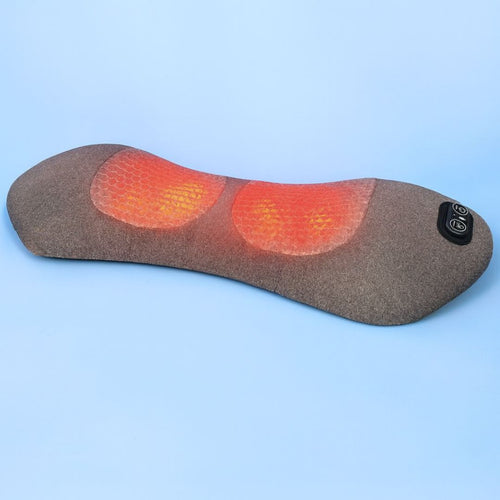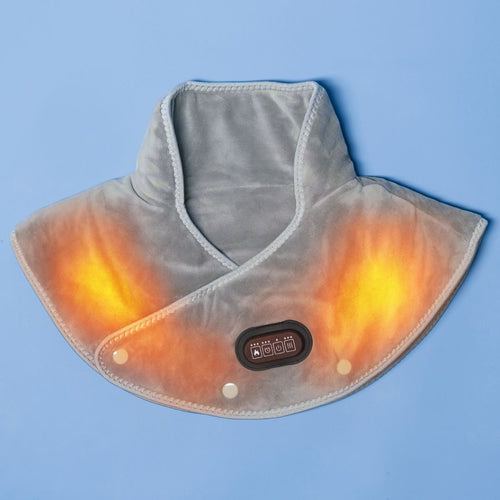Can Neck Pain Cause Nausea Even Without Other Symptoms?
By Holly Grace Callis | Published on August 1st, 2025

You’re not sick, not dizzy, and don’t have a fever. Yet nausea keeps showing up alongside that deep ache in your neck. It feels strange, but it’s more common than most people think.
Neck pain can do more than cause stiffness. It can also affect your nerves, blood flow, and balance. All of these can contribute to nausea, even when no other symptoms are present.
In this blog, we’ll explain how neck tension can trigger nausea, why it happens, and what you can do to feel better naturally.
Here’s Why Neck Pain Can Cause Nausea
Even without visible symptoms, neck pain can disrupt key systems in your body. The nerves and muscles in your cervical spine are closely connected to your balance and circulation. When these are affected, nausea can follow.
Cervical Spine Nerve Involvement
The upper part of your neck holds nerves that connect to your head, ears, and inner balance system. When these nerves are compressed or irritated, usually from poor posture or muscle tension, they can send confusing signals to your brain. That mismatch can cause you to feel lightheaded or queasy, even without spinning or dizziness.
Muscle Tension and Blood Flow Disruption
Tight muscles in the neck can limit blood flow to areas like the brainstem. They can also disrupt signals from the inner ear, which helps manage balance. When this system is off, you may feel unsettled or nauseated. Even slight misalignments or inflammation can make a difference.
Lesser-Known Symptoms That Can Accompany Neck Pain

Neck pain doesn’t always come with clear signs like soreness or stiffness. In many cases, it manifests through subtle symptoms that are easy to overlook or misdiagnose. Nausea is one of them, but it's not alone.
You may also experience:
-Nausea
-Brain fog or trouble focusing
-Jaw tension or tightness
-Ear pressure or ringing
-Dizziness or light sensitivity
These symptoms often come and go, making them harder to trace back to neck issues. But if they show up alongside neck discomfort or poor posture, they may be connected.
Supportive tools like a cervical pillow can ease muscle tension and improve alignment, which often helps reduce these symptoms over time.
5 Ways to Relieve Nausea Caused by Neck Pain

If your nausea is linked to neck tension, addressing the root causes, like your posture, alignment, and circulation, can bring relief. These five methods target the physical stress that may be making you feel unwell.
1. Release Muscle Tension With Gentle Traction
Gentle traction helps reduce pressure on nerves in the cervical spine. A cervical-support pillow or a device designed for at-home traction can provide this effect safely. It creates space between the vertebrae, easing tight muscles and calming irritated nerves that may be contributing to nausea.
2. Apply Heat to Reduce Stiffness
Heat increases blood flow and relaxes tight muscles. A warm compress or heated neck pillow, like the Thera Puillow, placed on the back of the neck can ease stiffness, improve circulation, and calm the nervous system. When tension is reduced, related symptoms like nausea often improve too.
3. Stay Hydrated and Manage Stress
Dehydration and stress can both make neck tension worse. When your muscles are tight and your nervous system is on high alert, symptoms like nausea are more likely to appear. Drinking enough water and using calming techniques such as breathing exercises can help reduce overall tension.
4. Consider Natural Anti-Inflammatory Support
Neck pain often involves low-grade inflammation. Natural supports like herbal pain patches may ease this without the side effects of medication. These patches deliver targeted relief to the neck area, which may help reduce the nerve irritation or muscle tightness linked to nausea.
5. Improve Sleep Positioning
Poor neck alignment during sleep can make symptoms worse. Sleeping on your stomach increases strain on the cervical spine, while flat or unsupportive pillows can cause misalignment. A cervical-support pillow helps keep your spine in a neutral position and may reduce the overnight buildup of tension that contributes to nausea during the day.
When to See a Doctor About Neck Pain and Nausea

If nausea becomes frequent or more intense, it’s time to seek medical advice. You should also see a doctor if you experience:
-Vision changes
-Numbness or tingling
-Fever
-Severe pain when moving your head
-Dizziness that worsens with neck movement
-Swollen glands in the neck
-Chest pressure or pain
These may signal a neurological issue or infection. According to a study from Harvard, it’s critical to get prompt medical care for symptoms involving balance, vision, or coordination, especially when they appear with neck pain.
Feel Better From the Neck Down
Neck pain can show up in unexpected ways. Even if you don’t feel dizzy or sore, tension in the upper spine may still be causing nausea or discomfort. The connection isn’t always obvious, but it is real and manageable.
By improving your posture, supporting your cervical spine, and using simple daily tools, you can reduce both neck pain and related symptoms. Gentle traction, heat, hydration, and better sleep positioning are all small changes that can lead to lasting relief.
Need extra support? Our reputable neck pain relief products can help find relief today.
FAQs About Neck Pain and Nausea
Can a pinched nerve in the neck cause stomach problems?
Yes. A pinched cervical nerve can affect nearby muscles and nerves that help control balance and digestion. When balance signals are disrupted or tension spreads to nearby systems, you may feel nauseated, lose your appetite, or experience vague stomach discomfort, especially when the neck is tense or inflamed.
Is nausea a symptom of cervical stenosis?
It can be, especially when the stenosis compresses nerves that influence balance and coordination. Cervical stenosis narrows the spinal canal, which can put pressure on the spinal cord or nerve roots. This may cause symptoms like dizziness, lightheadedness, or nausea, even without direct neck pain.
What is a red flag in neck pain?
Red flags include sudden, severe neck pain along with numbness, weakness, difficulty speaking, or loss of coordination. These symptoms may indicate spinal cord involvement or another serious condition. If any of these signs appear, seek medical attention right away to rule out neurological damage or vascular issues.
What are the 5 D’s for neck pain?
The “5 D’s” help identify serious signs of cervical spine or brainstem involvement:
-Dizziness
-Diplopia (double vision)
-Dysarthria (difficulty speaking)
-Dysphagia (difficulty swallowing)
-Drop attacks (sudden falls without warning)
If you experience any of these symptoms, especially after recent neck pain or trauma, get medical care immediately. These signs may point to a serious condition requiring prompt evaluation.









